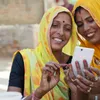
Bridging the accessibility gap for healthcare in rural India remains an imperative challenge, underscored by the stark disparities between urban and rural healthcare infrastructures.
Despite governmental initiatives, rural communities—constituting a significant portion of India’s population—grapple with limited access to even fundamental healthcare services.
The concentration of healthcare resources in urban centres exacerbates this issue, leaving rural regions underserved and vulnerable.
Addressing this challenge demands a multifaceted approach encompassing innovative solutions, infrastructure development, training programmes, and technology integration—all to ensure equitable access to quality healthcare services.
The healthcare landscape in India paints a concerning picture of inequity, with about 75% of healthcare resources concentrated in urban areas, serving only 30% of the population. This disparity is evident in the distribution of healthcare professionals, with 74% of doctors stationed in urban areas, catering to a mere 28% of the populace.
Additionally, the prevalence of multi-speciality hospitals, primarily in major cities, underscores the limited access to specialised care for rural residents.
The consequences of this healthcare gap manifest into a “broken patient journey” for rural residents. Patients often struggle to access even basic medical care, resorting to unqualified practitioners or enduring long journeys to distant cities for treatment.
The lack of accessible healthcare locally necessitates the involvement of healthcare brokers, exacerbating the fragmentation of the healthcare experience.
Addressing these healthcare challenges requires a focus on the three A’s—accessibility, attention, and availability.
By covering these essential elements, rural healthcare initiatives can bridge gaps and improve overall health outcomes for underserved populations in India.
.thumbnailWrapper{
width:6.62rem !important;
}
.alsoReadTitleImage{
min-width: 81px !important;
min-height: 81px !important;
}
.alsoReadMainTitleText{
font-size: 14px !important;
line-height: 20px !important;
}
.alsoReadHeadText{
font-size: 24px !important;
line-height: 20px !important;
}
}

Accessibility: reaching every corner
Accessibility is the cornerstone of effective rural healthcare. In vast and remote regions, geographical distance poses a significant barrier to accessing medical services.
Additionally, financial constraints often exacerbate this issue, making healthcare unaffordable for many rural inhabitants. To address these challenges, telemedicine and mobile health applications have emerged as lifelines for rural communities.
The urgent need of the hour is to establish physical health clinics in Tier III cities or implement mobile clinics, which would offer doctor consultations, medications, and pathological tests, and bridge the gap between rural patients and high-quality healthcare services available in urban areas.
Attention: personalised and culturally sensitive care
Attention to the unique needs of rural populations, such as distinct cultural norms, beliefs, and healthcare-seeking behaviours, is crucial for delivering effective healthcare.
Tailoring healthcare interventions to align with these cultural contexts enhances patient engagement and improves health outcomes. Additionally, investing in community health workers familiar with the local culture and language can bridge communication gaps and foster trust between healthcare providers and rural residents.
Healthcare initiatives can ensure rural populations receive the attention they deserve by prioritising personalised and culturally sensitive care.
Availability: strengthening infrastructure and resources
The availability of healthcare infrastructure, trained professionals, and medical supplies is essential for meeting the healthcare needs of rural India, which often faces shortages of healthcare facilities and personnel.
Addressing these gaps requires comprehensive strategies that focus on infrastructure development, capacity building, and resource allocation.
Building and upgrading rural healthcare facilities, providing training and support for healthcare professionals serving in rural areas, and ensuring a steady supply of essential medicines and equipment are critical steps toward improving availability.
Additionally, leveraging AI and ML algorithms can optimise resource allocation, enhance diagnostic accuracy, and streamline patient care processes, further bolstering healthcare availability in rural India.
.thumbnailWrapper{
width:6.62rem !important;
}
.alsoReadTitleImage{
min-width: 81px !important;
min-height: 81px !important;
}
.alsoReadMainTitleText{
font-size: 14px !important;
line-height: 20px !important;
}
.alsoReadHeadText{
font-size: 24px !important;
line-height: 20px !important;
}
}

Advancing healthcare equity in rural India
Covering the A’s in healthcare for rural India—Accessibility, Attention, and Availability—is essential for advancing healthcare equity and improving health outcomes in underserved populations.
Rural healthcare initiatives can bridge gaps and address the unique healthcare challenges faced by rural communities by ensuring healthcare services are accessible, culturally sensitive, and adequately resourced.
Through collaborative efforts involving government agencies, non-governmental organisations, healthcare providers, and tech companies, we can work towards a future where every individual in rural India has equitable access to quality healthcare, regardless of geographic location or socioeconomic status.
Priyadarshi Mohapatra is the Founder and CEO of CureBay.
Edited by Suman Singh
(Disclaimer: The views and opinions expressed in this article are those of the author and do not necessarily reflect the views of YourStory.)







![Read more about the article [Scoop] PhonePe receives over Rs 740 Cr capital infusion from Singapore parent](https://blog.digitalsevaa.com/wp-content/uploads/2022/10/phonepe11561023770690-1578482785956-300x150.png)


